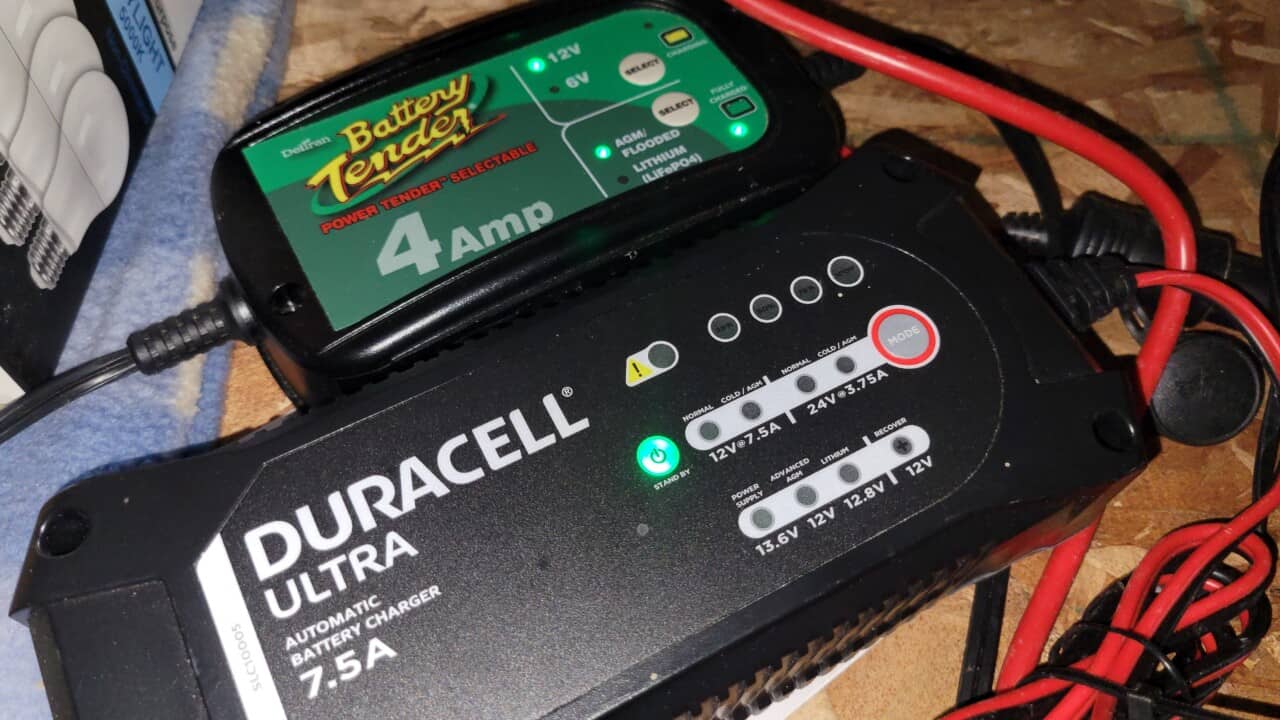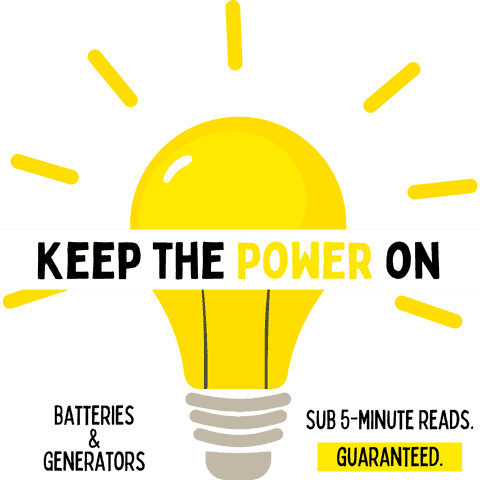Whether you’ve got a car, marine, or golf cart battery — they all need to be charged from time to time. If you don’t do it correctly, you’re probably going to be wondering why you’re smelling rotten eggs and why your battery sounds like a pot of pasta bubbling on a rolling boil.
This article is going to stay brief and high level. We’re going to discuss what is normal, what isn’t, and what mistakes you need to avoid making so that you don’t ruin your battery or burn your lungs from the fumes.
Listen to the article below by hitting the play button below and feel free to scroll the page for any helpful visuals. All of the articles on this website will have this audio feature for your convenience.
Should a Battery Be Bubbling When Charging?
A low bubble that can only be heard when your ear is near the charging battery, like that of a carbonated beverage, is completely normal if the battery is being properly charged. A bubble that sounds like a rolling boil, or results in hissing, steaming, bulging of the battery walls, or the smell of rotten eggs is not normal and is an indication that you are severely overcharging your battery — likely from an over-sized charger.
When you charge a battery with a wall charger, what essentially is happening is your battery is converting electricity into stored chemical energy. The battery can only do this at a certain rate, depending on its current state of charge.
The more depleted a battery is, the faster it can convert. The more full it gets, the slower it converts.
If you were to blow up a balloon with your mouth, you’d be able to force lots of air into it at first. If you wanted to get it to absolute maximum capacity without popping it, you’d slow down significantly as you proceeded since the balloon was reaching its maximum potential. It’s the same concept with your battery.

We don’t need get to get into the chemistry to understand that the molecules in the electrolyte can only be converted into stored chemical energy at a certain rate with the amps passing through the electrolyte from the charger. If there are more amps than the battery can convert, then the battery electrolyte will get hotter as the excess electricity engages in electrolysis.
This is essentially the excess electricity (that cannot be readily converted into chemical energy) destroying water molecules in the electrolyte solution and causing it to boil. This results in heat and steam. Basically, the battery is trying to get rid of the heat generated by the excess electricity.
The more you’re overcharging it, the louder the noise will be, the more noxious fumes you’ll generate, and the more you’ll damage your battery.
If you don’t hear anything when you get near the battery, then the amperage is below the threshold that the battery has for converting the electricity into chemical energy. This is totally fine and safe for the battery.
If you hear the sound of carbonation, like from your favorite beverage, then this is also common and very normal. It indicates that your battery charger is trying to stay right at the maximum threshold that your battery has at that given moment for converting the electricity into stored chemical energy. Remember that the battery’s ability to convert changes constantly as the state of charge changes. Your smart charger is using its diagnostic capabilities to try to stay right at that level.
If you hear a rolling boil, hear hissing, smell rotten eggs, or see the walls on your battery starting to bulge out — then something is very wrong. Unplug the charger immediately until you figure out what went wrong.
| Sound Heard when Charging | What’s Happening |
|---|---|
| No sound but charger is working | Completely normal; Charger may actually be slightly undersized for the battery |
| Sound like a carbonated beverage | Normal; Charger is trying to match the battery’s maximum ability to convert the amperage into stored chemical energy |
| Rolling Boil | Not normal, potentially dangerous to both you and the battery; Ventilate area, unplug charger, troubleshoot (see below) |
What Causes a Battery to Bubble When Charging?
Typically, you’ll experience a bubbling battery for one of several reasons:
- Your charger is over-sized (amps) for your battery (most common)
- Your charger is performing a “reconditioning” or “desulfation” session on your battery
- Your charger is malfunctioning
- Your battery’s cells are compromised (too low of electrolyte, a shorted out cell, etc.)
| Battery Bubbling Issue | Likelihood | How to Fix |
|---|---|---|
| Over-sized charger for the battery in question (Overcharging) | Very Common | Keep your charging amps at 10% or less than the battery’s total Ah (amp hour) rating |
| Charger in Desulfation/Equalization Mode | Common | Switch to a charger that doesn’t have this feature, requires that you manually toggle it, or allow it to finish this “controlled overcharge” |
| Battery Damaged / Low on Electrolyte | Rare / Common | Refill a flooded battery (has caps that pop off) with distilled water so that exposed plates are covered before charging; Sealed batteries cannot be serviced |
| Charger Doesn’t Have a Float Mode (Overcharging after battery is full) | Common | Use a newer smart charger with a float mode or remove your charger from battery after it is at 100% |
| Charger Malfunctioning | Rare | Rule out the top 4 reasons and then buy a new battery charger |
Typically, the reason is that a charger with too high of an amperage output has been hooked up to a battery with too little capacity for that given charger.
It would be like trying to inflate a normal birthday balloon with a 50psi air compressor. The balloon is just going to pop from the sheer force of the air coming into it.
The general rule is to use a charger with an amp rating that is 10% or less than your battery’s total ampere hours (Ah) on the sticker. For instance, if your battery was 50Ah on the sticker, you would want to use a 5 amp charger or less, but not so low that you’re waiting for days for it to charge.
If you hook up a 20-amp charger to a 50Ah battery, it’s going to be impossible for the battery to convert the 20-amps into chemical energy at any given time. There’s simply too much amperage and the battery will not be able to convert it fast enough without bubbling and overcharging.
What to do if a Battery is Bubbling When Charging
If your battery is louder than a carbonated beverage (especially if you can hear it bubbling from 10′ away), then unplug your battery immediately.
Check the sticker on your battery and then compare it to the amp rating of your charger. Make sure the charger is 10% or less when compared to the battery’s overall Ah rating. A little more or a little less is generally acceptable, but use this rule as a good rule of thumb.
If your charger is too large (a 15 amp charger for a 40Ah battery, for example), then replace it with a smaller one of the appropriate size.

If the charger is correct, make sure that it hasn’t entered into a “desulfation”, “equalization” or “reconditioning” mode. This is when the battery charger (sometimes automatically, depending on the brand) will perform a “controlled overcharge” in order to agitate the electrolyte and knock off any of the lead sulfate that has started forming on the plates which will diminish the performance of the battery.
It’s up to you if you want to allow this process to continue after you notice it. I prefer a brand that does NOT perform this process automatically and instead must be manually activated.
It is also best practice to have plenty of ventilation in an area with a overcharging battery, as the hydrogen sulfide released (rotten egg smell) is poisonous.
Battery Types and Bubbling When Charging (Flooded, AGM, GEL)
Lead-acid batteries batteries are the most commonly used for vehicles, boats, and golf carts.
They come in several forms: flooded (where you can pop the caps), GEL sealed, AGM sealed.
Flooded batteries are the most forgiving with overcharging, as evaporated water can be replaced.
Flooded batteries can generally charge at 13.8 volts to 14.7 volts with minimum bubbling.
Both sealed batteries cannot have their electrolyte replaced if it actually escapes the pressure release vent. However, as long as the voltage is low enough (the pressure behind the amps), then the sealed batteries will recombine any of the evaporated electrolyte back into the battery.
It’s best to keep GEL batteries at 14.1 volts or below and AGM batteries below 14.6 volts. Exceeding these voltages could result in internal pressures getting too high and the evaporated electrolyte leaving the battery via the pressure release instead of recombining.
You can easily monitor charging voltages by using a set of alligator clips with a DC plug, and a DC plug-in digital voltmeter as seen in the picture below.
